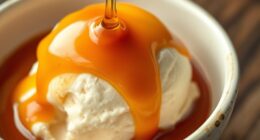You might be wondering if dogs can eat ice cream, but it's best to avoid it. Many dogs are lactose intolerant and can suffer digestive upset from regular ice cream. Plus, the high sugar content can lead to obesity and other health problems. Certain flavors, like chocolate or those containing xylitol, are extremely toxic. Instead, you can find dog-friendly ice creams or make your own with safe ingredients. If your dog does sneak a lick, keep an eye out for any unusual symptoms. Stick around to discover more about safe treat options for your furry friend.
Key Takeaways
- Many dogs are lactose intolerant, which can lead to digestive issues if they consume ice cream.
- Ice cream often contains high sugar levels, increasing the risk of obesity and diabetes in dogs.
- Certain flavors, like chocolate and coffee, are toxic to dogs and can cause severe health issues.
- Xylitol, a sweetener found in some ice creams, is extremely toxic and can lead to life-threatening conditions for dogs.
- Opt for dog-friendly ice cream or homemade treats using safe ingredients like pureed fruits or plain yogurt.
Risks of Ice Cream for Dogs
When it comes to sharing ice cream with your dog, you need to be aware of several risks involved. First off, many dogs are lactose intolerant, meaning they can't properly digest dairy. This can lead to serious digestive upset after they indulge in even a small amount of ice cream.
Additionally, the high sugar content in most ice cream flavors can cause health problems like obesity and diabetes, especially since a single scoop might surpass your dog's daily calorie needs. It's crucial to recognize that just like with humans, certain essential oils can promote relaxation in dogs, so there are safer ways to treat them without the risks associated with ice cream.
Moreover, some ice cream flavors, such as chocolate and rum raisin, are toxic to dogs and can result in severe reactions like vomiting and seizures. You also need to watch out for ingredients like xylitol, a sweetener found in some frozen treats that's extremely toxic to dogs, potentially causing hypoglycemia and liver failure.
Nutritional Concerns

When you think about sharing ice cream with your dog, consider the nutritional concerns that come with it.
Many dogs are lactose intolerant, which can lead to uncomfortable digestive issues, similar to how many cats react to lactose-containing treats like whipped cream.
The high sugar content can contribute to obesity, making it important to monitor treat intake and consult a veterinarian if you're unsure about what's safe for your pet's diet cat dietary considerations.
Balancing your dog's treats with their health needs is essential for their well-being.
Lactose Intolerance Risks
Lactose intolerance is a common issue among adult dogs, as many produce less lactase after weaning. This condition makes it tough for dogs to digest lactose, leading to potential digestive issues when they consume high-fat dairy products like ice cream. The symptoms of lactose intolerance can vary greatly; some dogs may only have mild discomfort, while others may experience severe gastrointestinal distress.
Here's a quick overview of lactose intolerance risks for dogs:
| Symptoms | Severity | Dairy Alternatives |
|---|---|---|
| Loose stools | Mild | Plain yogurt (small amounts) |
| Diarrhea | Moderate | Low-fat cottage cheese |
| Vomiting | Severe | Lactose-free products |
| Gas or bloating | Variable | Non-dairy options |
| Pancreatitis risk | High with high-fat | Frozen fruit treats |
It's important to monitor your dog's reaction to any dairy products. Regular consumption of ice cream can worsen lactose intolerance symptoms and potentially lead to long-term digestive discomfort. Always consult your vet before introducing new treats to your dog's diet.
Sugar and Obesity
Ice cream may seem like a delightful treat for your dog, but its high sugar content poses serious nutritional concerns. The sugar in ice cream can lead to weight gain, which often results in obesity. For small dogs, just one scoop can exceed their daily caloric intake, making it easy for them to pack on the pounds if given regularly.
Moreover, dietary management is essential in preventing obesity and associated health issues in dogs. Overweight dogs face numerous health risks, including diabetes, joint problems, and heart disease. Additionally, consuming high-sugar foods can adversely affect your dog's dental health, increasing the risk of periodontal disease. You wouldn't want your furry friend to suffer from painful teeth or gums due to occasional treats.
To keep your dog healthy, it's vital to monitor portion sizes and guarantee that treats make up no more than 10% of their daily caloric intake. This way, you can indulge your pup without jeopardizing their well-being.
Instead of ice cream, consider healthier alternatives that satisfy their sweet tooth while keeping sugar levels in check. Remember, moderation is key to preventing obesity and maintaining your dog's overall health.
Lactose Intolerance in Dogs

Many dog owners may not realize that their furry friends can struggle with lactose intolerance. After weaning, many adult dogs produce less lactase, the enzyme needed to digest lactose found in dairy products. It's estimated that about 50% to 80% of adult dogs experience some level of this intolerance, leading to digestive issues when they consume high-fat dairy like ice cream.
Here's a quick overview of the symptoms and potential risks:
| Symptoms of Lactose Intolerance | Risks of High-Fat Dairy Products |
|---|---|
| Loose stools | Gastrointestinal discomfort |
| Diarrhea | Risk of pancreatitis |
| Vomiting | Not safe for dogs with sensitivity |
If you're considering giving your dog ice cream or any dairy product, monitor them closely the first time. The severity of symptoms can vary considerably among individual dogs. While some may tolerate small amounts, others may experience severe reactions. Always consult with your veterinarian to determine what's safe for your dog and guarantee their digestive health remains a priority.
Harmful Ingredients to Avoid

When it comes to ice cream, you need to watch out for harmful ingredients that can seriously harm your dog.
Xylitol, found in sugar-free options, is incredibly toxic and can lead to life-threatening conditions.
Additionally, flavors like chocolate and certain nuts pose significant risks, so it's essential to read labels carefully before sharing any treat.
Xylitol and Its Dangers
One ingredient that dog owners must be particularly wary of is xylitol, a sugar substitute often found in sugar-free foods, including some types of ice cream.
Xylitol is highly toxic to dogs, even in small amounts. Ingesting it can cause a rapid release of insulin, leading to hypoglycemia. This condition can manifest through symptoms like lethargy, vomiting, and seizures. Furthermore, xylitol can lead to liver failure, making it essential to avoid any food products containing this harmful ingredient.
To protect your furry friend, always check for xylitol and other harmful additives by following these steps:
- Read Ingredient Labels: Always scrutinize the labels of any ice cream or treats.
- Beware of Sugar-Free Products: Many sugar-free items contain xylitol, so be cautious.
- Know the Dosage: Even as little as 0.1 grams per kilogram of body weight can pose a risk.
- Consult Your Vet: If you're unsure about a product, ask your veterinarian for guidance.
Toxic Flavors to Avoid
Certain ice cream flavors pose significant risks to your dog's health, making it essential to be aware of what you're sharing.
Chocolate ice cream is particularly dangerous, as it contains theobromine, which can lead to vomiting, diarrhea, and even seizures.
Xylitol, often found in "sugar-free" options, is another toxic flavor to avoid. Even tiny amounts can cause hypoglycemia, seizures, or liver failure in dogs.
Flavors like rum raisin shouldn't be on your dog's treat list either, due to raisin toxicity, which can lead to kidney failure.
Coffee-flavored ice creams also come with risks, as caffeine can make dogs restless, cause rapid breathing, and lead to life-threatening symptoms.
Be cautious with nut-based ice creams too. Some may contain macadamia nuts, which are toxic to dogs and can result in weakness, tremors, and hyperthermia.
Always check the ingredients before sharing any ice cream with your furry friend. Keeping your dog safe means steering clear of these toxic flavors, ensuring they only enjoy treats that are safe and healthy for them.
Sugar and Obesity Issues

Ice cream may seem like a delightful treat for your furry friend, but its high sugar content poses serious risks. Feeding your dog sugary treats like ice cream can lead to significant health issues, including obesity. Just a single scoop can easily exceed your dog's daily calorie recommendations, resulting in unwanted weight gain.
Here are some key points to reflect upon:
- Sugar Intake: Excessive sugar can disrupt your dog's digestive system and lead to metabolic disorders.
- Obesity Risks: Weight gain from sugary treats increases the likelihood of obesity, which can shorten your dog's lifespan.
- Health Issues: High sugar consumption is linked to dental disease and diabetes in dogs.
- Treat Limits: Treats should only make up about 10% of your dog's overall diet to help prevent obesity and related complications.
Dog-Friendly Ice Cream Options

When it comes to treating your dog, dog-friendly ice cream options are a fantastic choice that keeps their health in mind. These specially formulated ice creams are low in sugar and contain safe ingredients, ensuring your furry friend can enjoy a tasty treat without harmful effects.
Many commercial brands offer dog ice creams made with dog-safe ingredients like peanut butter, pumpkin, or yogurt, which are easier for dogs to digest.
If you prefer homemade treats, making dog-friendly ice cream at home is simple and fun! You can blend frozen bananas or puree dog-safe fruits to create a nutritious frozen delight.
For an extra invigorating option, consider freezing plain apple sauce or pumpkin puree into popsicles, perfect for hot days.
Always check product labels to avoid harmful additives and stick to treats designed specifically for dogs.
By choosing dog-friendly ice cream options, you're giving your pup a delicious, safe treat that they'll love, while also prioritizing their health.
Safe Homemade Treats

Making safe homemade treats for your dog is a rewarding way to show your furry friend some love. Instead of ice cream, consider these nutritious and dog-safe alternatives that are easy to make and delicious for your pup:
- Frozen Bananas: Blend frozen bananas until creamy for a delightful, ice cream-like texture that's easy to digest.
- Plain Yogurt Pops: Freeze plain yogurt (with low lactose) in molds for a rejuvenating treat that's gentle on your dog's stomach.
- Peanut Butter Mix: Combine crushed frozen fruit with dog-safe peanut butter for a flavorful and healthy twist that your dog will adore.
- Fruit Popsicles: Freeze plain applesauce or pumpkin puree in ice cube trays to create simple, tasty popsicles.
These homemade treats not only provide a fun way to cool down your dog but also guarantee you're giving them safe, wholesome snacks.
What to Do If Your Dog Eats Ice Cream

If your dog sneaks a bite of ice cream, it's important to stay calm and assess the situation. First, identify the type of ice cream consumed. Plain vanilla is usually safe, while flavors like chocolate can be toxic. Next, monitor your dog for any signs of illness, such as vomiting, diarrhea, or lethargy, which may indicate a negative reaction to the ice cream.
| Ice Cream Type | Risk Level | Action Needed |
|---|---|---|
| Plain Vanilla | Low | Monitor your dog for symptoms |
| Strawberry | Moderate | Watch for digestive issues |
| Chocolate | High | Contact your veterinarian |
| Nut Flavors | High | Contact your veterinarian |
| Small Amounts | Minimal | Monitor your dog |
If your dog exhibits severe symptoms or has consumed harmful flavors, contact your veterinarian immediately. Remember, while small amounts of ice cream typically pose minimal risk, the high sugar and fat content can lead to long-term health issues. Document any adverse reactions after your dog eats ice cream to help identify potential food sensitivities in the future.
Frequently Asked Questions
What Happens if a Dog Eats Ice Cream?
If your dog eats ice cream, it could face serious issues; over 50% of dogs are lactose intolerant. Watch for signs like vomiting or diarrhea, and consult your vet if symptoms persist.
What Kind of Ice Cream Can Dogs Eat?
When considering ice cream for your dog, opt for plain vanilla in small amounts if they're not lactose intolerant. Better yet, choose dog-friendly alternatives made with safe ingredients like peanut butter or pumpkin. Always check labels!
Why Can't Dogs Eat Vanilla Ice Cream?
Vanilla ice cream's sugary sweetness, serious sugars, and sneaky substances can seriously harm your dog. Lactose leads to tummy troubles, while high fat and potential toxins pose perilous risks. Best to skip it for your furry friend!
Can My Dog Lick My Ice Cream?
You can let your dog lick your ice cream occasionally, but be cautious. Many dogs are lactose intolerant, and high sugar content can lead to health issues. Always monitor their reaction after indulging.
Conclusion
To sum up, while sharing a scoop of ice cream with your furry friend might seem tempting, it's crucial to be mindful of the risks involved. Did you know that around 50% of dogs are lactose intolerant? That means half of all pups could end up with an upset stomach after a treat. Instead, opt for dog-friendly ice cream or whip up some safe homemade treats to keep your canine companion happy and healthy all summer long!










